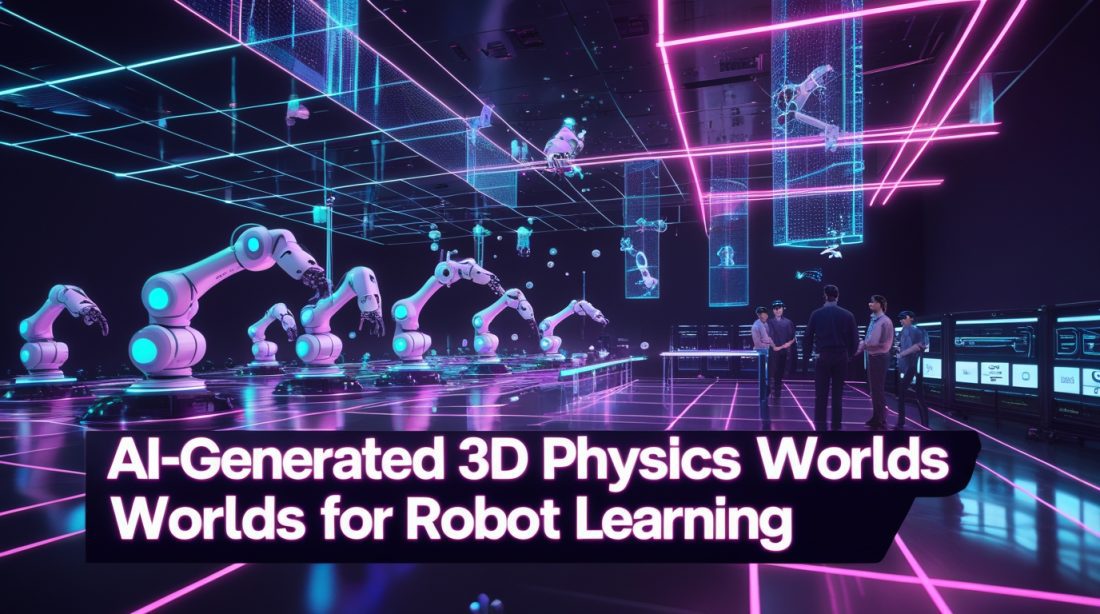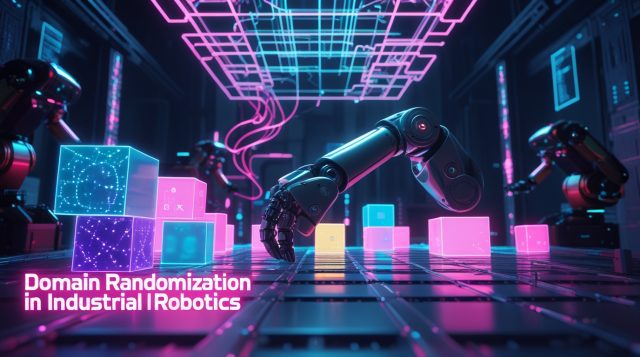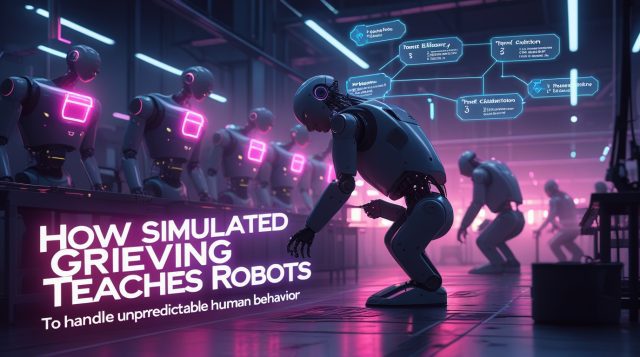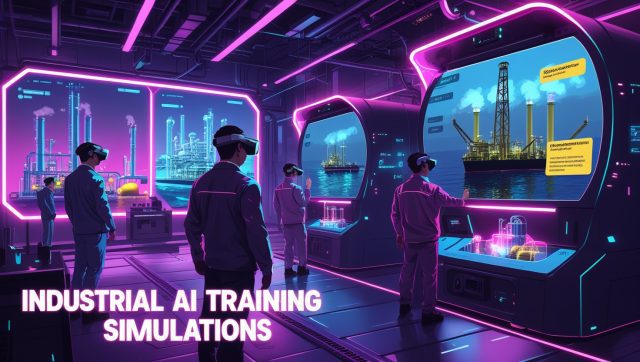In an industrial research lab, a team of engineers needs to train a robotic arm for a complex assembly task that normally would require months of real-world testing. Instead of deploying physical equipment, they type a simple text description: “A robotic arm assembles a gearbox component while avoiding nearby obstacles.” Within moments, a highly detailed 3D physics world generates automatically, and the training begins—compressing what would traditionally take decades of robotic training into mere hours.
This isn’t science fiction; it’s the reality brought forth by AI-generated 3D physics worlds for robot learning, powered by simulation platforms and text-to-simulation technology developed by Genesis AI and other pioneers in physical AI. For more on how these platforms are scaling robot training data exponentially, check out our breakdown of MIT’s generative AI strategies.
For manufacturers and industrial operations struggling with labor shortages and the need for flexible automation, this ultra-accelerated robot learning in industrial automation represents more than just a technical marvel—it’s becoming an economic imperative. With physical labor contributing an estimated $30–40 trillion to global GDP yet remaining 95% unautomated, the race to deploy adaptable robotic systems has intensified dramatically. Traditional robotics approaches have hit a fundamental limitation: they’re too brittle, expensive, and time-consuming to adapt to dynamic industrial environments. Learn how these gaps are fueling a $44 billion revenue surge in industrial AI robotics by 2025.
Why Ultra-Accelerated Training Matters for Industry
Industrial automation has always been constrained by the time-cost paradox—the tradeoff between training thoroughness and implementation speed. Traditional robot programming for each specialized task could take weeks or months, creating a significant bottleneck in operational flexibility. With AI-generated 3D physics worlds for robot learning and industrial digital twin simulation training, this constraint is being shattered, offering manufacturers unprecedented agility in responding to changing production needs.
The economic implications are staggering. According to industry analysis, only about 2,000 AI robots are currently deployed worldwide, representing a tiny fraction of their potential market. This scarcity isn’t due to lack of demand but rather the prohibitive costs and technical challenges of traditional robot training methods. Genesis AI’s approach addresses this directly by creating what they term a “scalable robot data generation synthetic data engine” that fuses real-world robot interaction, high-fidelity physics simulation and rendering, and Internet-scale embodied data. For deeper insights into why predictive maintenance AI is leading this efficiency wave, see our analysis on factory gains in 2025.
“Even in the most ‘automated’ industries today, the robot-to-human ratio rarely exceeds 1:30,” notes Charly Mwangi, a partner at Eclipse, “due to the long tail of tasks requiring dexterity, cognition, mobility, and real-world reasoning that current robots simply can’t handle.”
These innovations now help close that gap through industrial automation labor shortage solutions and adaptive manufacturing robot simulation.
How Text-to-Simulation Technology Actually Works
At the core of this revolution lies AI-generated 3D physics worlds for robot learning—a sophisticated blend of generative AI industrial simulation and differentiable physics engine robot training that transforms natural language descriptions into fully realized training environments. NVIDIA’s latest advancements in cloud-connected humanoid simulations are accelerating this even further, as detailed in their 2025 factory blueprint.
The process begins with what Genesis describes as a “multi-physics simulation robot learning system rebuilt from the ground up, capable of simulating a wide range of materials and physical phenomena.” Unlike traditional simulators, these platforms handle everything from granular materials to articulated robotic systems with equal fidelity.
When an engineer inputs a prompt like “A mobile Franka arm reorganizes books on a table,” several advanced systems activate:
- Scene Comprehension: Vision-language models interpret the task.
- Physical World Generation: The simulator assigns accurate material properties for physics-accurate simulation robot learning.
- Task Optimization: Reinforcement learning and automated synthetic data generation robotics techniques begin stress-testing thousands of variations simultaneously.
These environments enable robotic policy generation from natural language, ensuring robots can learn complex manipulation skills quickly and safely. Explore practical reinforcement learning applications in our guide to robotics training transformations.
Real-World Industrial Applications and Use Cases
Manufacturing and Assembly Line Optimization
In automotive manufacturing, embodied AI training simulation platforms now transform how robots learn complex assembly tasks. Using industrial robot digital twin creation, companies can simulate and perfect workflows before physical deployment, reducing industrial robot training time dramatically. BMW’s humanoid precision breakthroughs exemplify this, covered in our exclusive on their manufacturing edge.
In one case, engineers reconfigured robotic welders using sim2real transfer AI training for manufacturing, achieving safe and efficient operation within 48 hours instead of weeks.
Logistics and Warehouse Automation
The chaotic nature of warehouses has made automation difficult, but automated robot policy generation and parallel robot instance training enable scalable adaptation. These systems build flexible robots capable of learning in multi-material simulation robotics environments. For real-world ROI boosts, dive into our warehouse cobot efficiency report.
“General-purpose robots powered by universal robotics foundation model physical AI will define the next major chapter of human history,” says Zhou Xian, CEO of Genesis AI.
The Technical Architecture Behind the Acceleration
Benchmark Performance Comparisons
The raw speed of these new GPU-accelerated robot learning simulation platforms distinguishes them from earlier tools. Genesis reports achieving up to 43 million FPS—hundreds of thousands of times faster than real time. This performance allows robot learning benchmark acceleration and supports industrial robot adaptability training at scale. Robotics simulation is now fully replacing physical prototyping, as we unpacked in our sim-to-real shift analysis.
Key architectural features include:
- GPU-accelerated parallel computation
- Auto-hibernation for static scenes
- Optimized collision detection
- Differentiable physics for gradient-based optimization
Bridging the Simulation-to-Reality Gap
The sim2real transfer AI training manufacturing challenge—transferring virtual learning into physical success—is being addressed with physics-accurate simulation robot learning and complex manipulation task simulation. These advances create robotic policies that translate effectively to real-world scenarios, enabling real-world robot data collection automation to further refine models. External benchmarks from NVIDIA’s Omniverse platform confirm up to 100x speed gains in industrial sim2real transfers.
Implementation Strategy for Industrial Adopters
A step-by-step adoption plan typically includes:
- Assessment Phase: Identify bottlenecks solvable with agile robot deployment in manufacturing.
- Proof of Concept: Use industrial digital twin simulation training to replicate shop-floor conditions.
- Integration: Build feedback loops using synthetic training data robot learning.
- Scaling: Deploy multi-physics simulation robot learning systems across facilities. Human-in-the-loop workflows are key to success here, saving millions as detailed in our cost-saving playbook.
The Future of Physical AI and Industrial Automation
The trajectory of ultra-accelerated robot learning in industrial automation points toward generalized intelligence via robotics foundation model industrial applications. This approach mirrors the rise of large language models but focuses on the physical world. Future factories will depend on universal robotics foundation model physical AI systems that continuously adapt, evolve, and learn—reducing the need for manual programming through natural language robot programming simulation. Industry leaders are already powering this profit surge, per our 2025 robotics trends guide.
Final Verdict
The rise of AI-generated 3D physics worlds for robot learning marks a turning point for industrial robot adaptability training and industrial automation labor shortage solutions. By using automated synthetic data generation robotics, industrial robot digital twin creation, and embodied AI training simulation platforms, manufacturers can compress decades of development into hours.As industries move toward scalable robot data generation synthetic data systems and sim2real transfer AI training manufacturing, the companies mastering ultra-accelerated robot learning will gain a lasting competitive edge. For external validation, McKinsey’s 2025 automation report projects $2.5 trillion in global savings by 2030.



